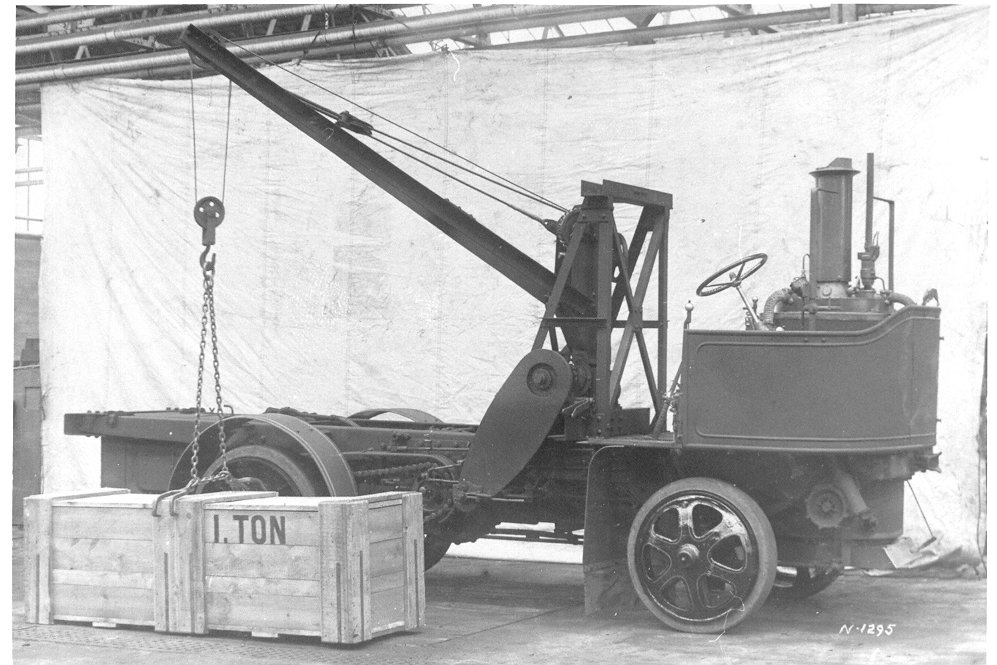
This is my wagon on a weighbridge at a local factory in 2002. The recorded weight was 7700kg (approximately 7 3/4 tons).
At the time there was a load of approximately 15cwt of coal on the back and the tank was full of water.
Brief History of Garrett Undertype Wagons
Garrett undertype wagons were built between the years 1921 and 1932, during which period several significant changes were made. The exact number of wagons built is debateable since at least one was rebuilt as a new vehicle and some that had been built for stock were dismantled and the parts used in other wagons. It is generally accepted that 307 wagons were built. The first wagons were of 6 tons capacity, soon to be followed by 4 and 8 tonners, supplied with platform bodies or as tipping wagons. In 1925 experiments were being undertaken with poppet valve engines. In 1926 the first six-wheeled wagon was made and in 1927 the piston valve engine was superseded by the poppet valve engine. Three "Suffolk Punch" six wheeled tractors designed for the export market were built; two of them remained in England and were sold to John Sadd & Sons timber merchants.
A list of Garrett undertype wagons is available here.
The lorry pictured above is fitted with a piston valve engine, the valves are actuated by Joy valve gear, which is driven by a linkage attached to the connecting rods. The water tube boiler has a working pressure of 250 psi. A tubular superheater is provided at the base of the chimney.
Wagons in the United Kingdom

My wagon no. 34841 a 6 tonner of 1926.

A little known Garrett wagon built at Leiston Works in about 1928.

6 wheeled tipper 35464 of 1931 under restoration in the UK.

8 ton tipper 35465 of 1931 preserved in the UK.
In addition to the above Simon Bass in Kent has obtained a large number of parts for a wagon which he is rebuilding as a replica of the Fullers Earth Union wagon no 34751. The rear axle came from Australia in the 1980s, with the crankshaft and countershaft that Tom Varley had obtained for my wagon. We are still trying to identify the wagon that these parts came from; they are for a 6 ton tipping wagon, evidence being that there is a tipping gear drive on the end of the crankshaft and the chain sprockets had 17 teeth. The boiler had been used for powering a small belt driven model engineering workshop in Kent, having been purchased for the workshop in 1934 from Hammond, who was a boiler dealer in Slough. In 1953 the owner borrowed a special long tube expander, for the rear end of the tubes, from Garretts to assist in retubing of the boiler. From an initial inspection, it appeared as though the boiler was from a wagon built c.1924-5; due to the clinker door being offset to the nearside and a historic photograph, of the boiler when acquired, showing an early type of superheater casting. Cleaning of the boiler under the manhole at the rear of the boiler revealed number 16496. This is the number of the boiler fitted to wagon number 34180, when sold new to C.E.Holden for the Union Haulage Co., Manchester. It was also the second boiler of the new design, which replaced the "Sentinel" type boiler originally fitted to the first wagon. The boiler number raised the question as to why the clinker door was not located on the front centreline of the boiler; but this could be explained by the fact that the boiler had been removed from the wagon in December 1924 and replaced. The old boiler was then reconditioned and sold in 1925 to the Azo Soap Co., Manchester. It is possible that the boiler was modified following removal from the wagon and, when the boiler is more accessible allowing inspection inside the firebox, confirmation of alterations having been made will be sought.

There are the remains of three wagons in Australia

6 ton tipper 34315, which is almost complete and is under restoration.

6 ton tipper 34405,which has no engine.

4 tonner 34625 of 1924, was discovered in a dismantled state, having been used as a source of nuts, bolts and other materials.
It was dispersed over a large area on a mine site in Queensland and recovered for preservation.

Wagons in New Zealand

The boiler of 34535 is displayed in Pigeon Park, South Island, New Zealand. The boiler was removed from the wagon and built into this "lokey" a log hauler.

6 ton wagon 34661 of 1924 is in New Zealand; this wagon also requires an engine.
The boiler shell, firebox and engine are from a Sentinel "Super" three way tipping wagon, which is under restoration in New Zealand.
South Africa

6 ton tipper 35358 (a wagon with a poppet valve engine) is at the James Hall Museum, Pioneer Park, Johannesburg.